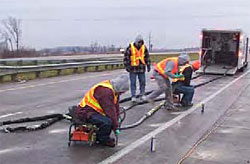Identification of the Best Practices for the Design, Construction, and Repair of Bridge Approach Sections (TR-481)
| Principal Investigator: | David White |
|---|---|
| Co-Principal Investigator: | Sivalingam Sritharan |
| Team Members: | Muhannad Suleiman, Mohamed Mekkawy & Sudhar Chetlur |
| Sponsor(s): | Iowa Department of Transportation |
| Start Date: | 08/15/2002 |
| End Date: | 12/31/2004 |
| Reports: | 01/31/2005, http://www.intrans.iastate.edu/reports/tr481.pdf 9.7 mb (*pdf) |
| Keywords: | Analytical Simulation of Structural Behavior |
Project Description:
Bridge approach settlement and the formation of the bump is a
common problem in Iowa that draws upon considerable resources for
maintenance and creates a negative perception in the minds of
transportation users. This research study was undertaken to
investigate bridge approach problems and develop new concepts for
design, construction, and maintenance that will reduce this costly
problem. As a result of the research described in this report, the
following changes are suggested for implementation on a pilot test
basis: Use porous backfill behind the abutment and/or geocomposite
drainage systems to improve drainage capacity and reduce erosion
around the abutment.
On a pilot basis, connect the approach slab to the bridge abutment.
Change the expansion joint at the bridge to a construction joint of
2 inch. Use a more effective joint sealing system at the CF joint.
Change the abutment wall rebar from #5 to #7 for non-integral
abutments.
For bridges with soft foundation or embankment soils, implement
practices of better compaction, preloading, ground improvement,
soil removal and replacement, or soil reinforcement that reduce
time-dependent post construction settlements.
Publications:
1) Identifying bridge approach problems, causes,
and possible solutions, Technology News, 09/15/2005
2) Best Practices for Bridge Approaches,
Tech transfer summary, 01/31/2005
